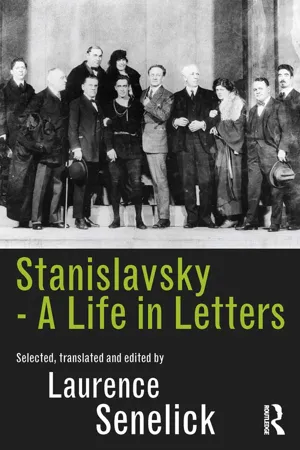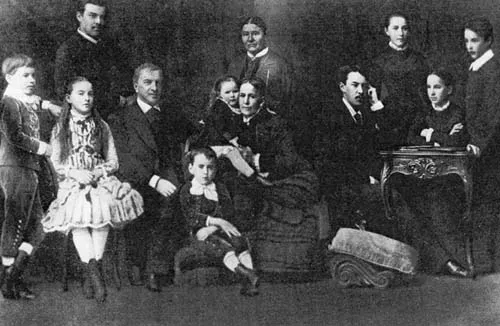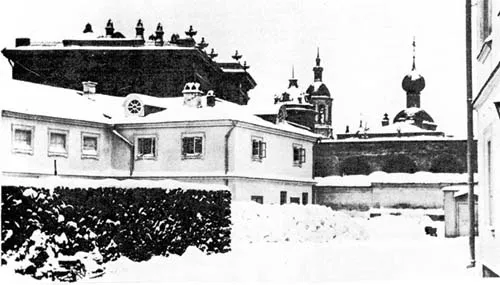![]()
A GILDED YOUTH
1863–1887
Blissful childhoods are the stuff of literary memoirs of the pre-Revolutionary period. Sergey Aksakov, Lev Tolstoy and Vladimir Nabokov are the most familiar writers to leave idyllic accounts of Edenic nests of gentry before the Fall. KS's recollections in My Life in Art convey a similar nostalgia for a vanished way of life. By all accounts they are not inaccurate. Cosseted by wealth and encouraged in his artistic predilections, he comes across as a privileged but unspoiled participant in a world of moneyed leisure and informed dilettantism. Unlike Aksakov and Tolstoy, scions of landowning gentry and nobility, and unlike Nabokov, son of a highly-placed statesman, KS belonged to the highest circle of Russian industrialists who united patriarchal manners with commercial integrity and a love of art and culture. By blood and sympathies, the Alekseevs were related to the art collectors the Tretyakov brothers and Sergey Mamontov, the creator of a private Russian Opera.
Yet the origins of the family were of the humblest. KS's great great grandfather was a Yaroslav peasant known only as Aleksey Petrov (‘son of Pyotr’, 1724–75); emancipated, he came to Moscow and, according to tradition, hawked dried peas from a tray. In 1746 he was enrolled in the merchantry and married another emancipated serf. Owing to his energy and that of his son Semyon (1751–1823), the family began to grow rich. Somehow Semyon perfected a procedure for weaving gold and silver thread, which was in demand for ecclesiastical altar cloths and liturgical garments. Having no family name was problematic, so he took on Serebrenikov (Silver-gilt), but it did not stick. Alekseev (‘those of Aleksey’) would become the proper name for both Semyon and his progeny. By 1812 he was a commercial magnate, capable of donating 50,000 rubles to the war effort against Napoleon. KS's grandfather Vladimir Semyonovich (1795–1867) founded the Vladimir Alekseev textile factory and occupied a prominent place in Moscow society. Fragrant with the aroma of Havana cigars, he lived like a king, but enjoyed a reputation for probity in business and close family ties. A cousin of KS, Nikolay, was honorary director of the Moscow Conservatory of Music and later mayor of Moscow (an appointment, not an elected office), who helped urbanize the capital.
The maternal side of KS's family was somewhat less reputable. The French actress Marie Varley (1800–85) came to St Petersburg in 1847 as a soubrette with the French troupe at the Grand Duke Michael Theatre. She left the stage to be kept as mistress of the marble contractor Vasily Abramovich Yakovlev and by him had two daughters whom she raised as Catholics; when he abandoned her, he acknowledged his bastards and had them brought up in his legitimate family. Varley, now known as Mariya Ivanovna Lapteva, was shunned by her children. One of them, Yelizaveta (actually Adèle) Vasilievna Yakovleva (1841–1904) was goddaughter of the famous actor Sosnitsky and a skilled pianist. When her sister got married, she ran away to Moscow where she met Sergey Vladimirovich Alekseev (1836–93). Bred up to the family business, he served as chairman of the board of the Alekseev Factory until his death. He enjoyed the rank of Hereditary Honorary Citizen, a distinction conferred only upon the most affluent, influential and respectable merchants. Sergey and Yelizaveta married in 1860 and had ten children, not all of whom survived to adulthood.
Since some of these siblings will appear regularly in KS's correspondence, usually under their nicknames, it is best to identify them now, in order of birth.
Volodya = Vladimir Sergeevich Alekseev (1861–1936), his mother's favourite; a member of the management of the VladimirAlekseev firm and a participant in the Alekseev Circle. Prone to stage fright, he left drama for music and became active in KS's Opera Studio.
Kokosya, Kotun = Konstantin Sergeevich Alekseev (1863–1938), known by his stage name Stanislavsky.
Zina = Zinaida Sergeevna Alekseeva (married name Sokolova, stage name Aleeva-Mirtova), 1865–1950); she acted in the family theatricals from 1879 and later taught her brother's System at the Opera Studio.
Nyusha = Anna Sergeevna (married names Shteker, Krasyuk, 1866–1936), member of the Alekseev Circle and the Society for Art and Literature, acting under the name Aleeva; at the MAT 1899–1903, when she left to have a baby.
Yura = Georgy Sergeevich Alekseev (1869–1929), amateur actor, a participant in the Alekseev Circle.
Lyuba = Lyubov Sergeevna Alekseeva (married names Struve, Bostanzhoglo, Korganova, 1871–1941).
Borya = Boris Sergeevich Alekseev (1871–1906), participant in all of KS's theatrical undertakings.
Pasha = Pavel Sergeevich Alekseev (1875–88), who died in childhood.
KS was born in Moscow on 5 January 1863. Shortly thereafter the family moved to a palatial mansion at Red Gates (Krasnye Vorota). He made his theatrical debut at age three or four, when he came on as Jack Frost in a domestic Christmas play and his costume caught fire. He noted that from an early age he felt ‘pleasure in success’, ‘joy in sensing an action on stage’ and the ‘painful feeling of inaction on the boards’.
In 1869 Sergey Alekseev bought an estate in Lyubimovka, about an hour's ride from Moscow, on the banks of the Klyazma River. There the summer months were spent and a free clinic set up. The diversions were continuous: the boys were excellent riders and sailed the river. In 1870 their governess introduced them to living pictures, and they indulged in cross-dressed farces, amateur theatricals involving the whole family, St John's Eve skirmishes presided over by ‘the Shah of Persia’, and an amateur circus that played a huge role in their lives. A never-ending cavalcade of guests took part in picnics and musicales. Back in the city the children were taught at home, and attended the Italian opera and the ballet. Open house was kept for artists and writers.
When KS was eleven, his parents travelled to St Petersburg with three of his siblings to have their daughter Nyusha examined by the eminent physician Dr S. P. Botkin. The account of the other children's activities, in KS's first preserved letter, confirms that the account of an idyllic childhood depicted in his later memoirs was no fabrication.
To his parents. 24 June 1874, Lyubimovka.
Dear Papa and Mama!
I hope that you arrived safely in Petersburg and that Lyuba and Borya didn't cry a lot. We got your letter and added to the special little circle.1 After you left Zina stopped missing you and we all went to swing in the hammock; after we'd swung a bit, we went to the gym, where we cut out paper soldiers and pasted them on cardboard. But we soon got tired of that, and we went to our room where, for the first time, I accompanied Volodya, who was playing a little pipe. Soon it was time for a swim. As you ordered, we sat in the water exactly five minutes and not once ducked our heads under. After the swim we had lunch. During lunch Anna Ivanovna visited us in a hired troika. After lunch we visited Auntie Vera2 and arrived just when everyone was gathering for a concert at Viktor Nikolaevich's.3 In their company we went home, because it was time for Yura and Zina to take a nap. We went to swing in Volodya's hammock. Then Volodya went into the study to compose a telegram. While Volodya was composing the telegram, we took naps. Volodya, Zina and Yura and I had splendid naps. Only Avdotya Aleksandrovna4 couldn't fall asleep until four o'clock. On Wednesday Volodya and I got up at eight and went for a swim. The water was very warm, so it was not very refreshing. After the swim we went to take tea. During tea-time we got your letter, Mama, the bouquets and the toys for Yura. Yura thanks you for the steamboat. After tea we went to sew flags and sewed them until dinner. After dinner a Punch-and-Judy show came by. After it left, there was a mighty downpour. During that time we wrote you letters, which we will send tomorrow morning […]
Figure 2 The Alekseev family, 1881. Left–right, standing: Boris, Vladimir, the nanny Fyokla Obukhova, Anna, Georgy. Left–right, seated: Lyubov, Sergey Vladimirovich, Pavel, Mariya, Yelizaveta Vasilievna, Konstantin, Zinaida
Konstantin Alekseev
In 1875 KS entered the second form of the fourth boys' classical gymnasium at Pokrovka as a day-scholar. Although well-behaved, he was a poor student, inattentive and uninterested in the curriculum. The Alekseev brothers had a crammer in the person of Ivan Nikolavich Lvov, (1857–1922), a poor mathematician. A graduate of Moscow University (1879) he later studied in the artillery school and the General Staff Academy, but had a reputation for being something of a ‘Red’. He would direct and take part in the first dramatic productions at Lyubimovka. He had a great influence on young KS and was the model for his interpretation of Vershinin in Three Sisters.
To his mother. 1875, Moscow.
Mama dearest!
[…] At the high school everything is fine, I haven't had any tests. I was often called on for answers this week and I think I gave the proper answers. I play the piano before dinner. Ivan Nikolaevich Lvov drops in at 6 o'clock and stays until we have done our homework. […]
Yours Kostya
Figure 3 The courtyard of the Alekseev Red Gates house
KS considered that his encounters with the art patrons of the merchant class, the Tretyakovs, Mamontov, the Sabashnikovs, the Shchukins, Aleksey Bakhrushin and Savva Morozov were among the most influential of his artistic impressions. These acquaintances and the prevalent spirit in his home gave him more of an education than the gymnasium and Lazarev Institute. He paid his first visits to Kiev and Petersburg and took a prominent place in the family circus but was already beginning to deplore amateurism, both of skill and attitude.
In adolescence KS transferred his interest to the dramatic theatre and attended the Maly Theatre with regularity. He especially admired Aleksandr Pavlovich Lensky (Vervitsiotti, 1847–1908), character actor, director, and master of makeup, and Glikeriya Nikolaevna Fedotova (Pozdnyakova, 1846–1925), an actress of wide range who played twenty-nine Ostrovsky roles as well as Shakespearean characters. He adored the Maly's grande dame Mariya Nikolaevna Yermolova (1853–1928), who stirred hearts with her tragic heroines. Rossi's5 King Lear struck him as a bolt from the blue.
To indulge his son's interests, in summer 1877 Sergey Alekseev had an annex built at Lyubimovka with an auditorium and stage, dressing-rooms, costume shop and props storage. On 5 September of that year it was inaugurated with a performance of the short farces The Old Mathe...


